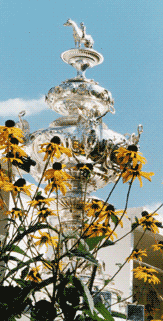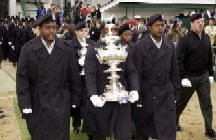Woodland Vase
The Most Valuable Trophy in American Sports
 The
elegant Woodlawn Vase, originally created by Tiffany and Company
in 1860 as a trophy for the now defunct Woodlawn Racing
Association in Louisville, is presented annually to the
Preakness winner.
The
elegant Woodlawn Vase, originally created by Tiffany and Company
in 1860 as a trophy for the now defunct Woodlawn Racing
Association in Louisville, is presented annually to the
Preakness winner.
The beautiful silver design assessed in 1983 for $1 million, is easily the most valuable trophy in American sports.
Standing 34 inches tall and weighing 29 pounds, 12 ounces, the Woodlawn vase has a colorful history as rich as the classic race at which it is presented. It has been raced for in Louisville, Elizabeth, N.J., the Coney Island Jockey Club, Jerome Park, Morris Park, and since 1917, at Pimlico Race Course. Created as a challenge cup, the Woodlawn Vase was first won by Capt. T. G. Moore's mare, Mollie Jackson, in 1861. The same owner retained possession the following year through the victory of the famous mare Idlewind. The outbreak of the Civil War prevented further competition until 1866. The vase in the meantime was buried at Woodlawn with others of the Moore family plate, lest it be discovered and melted into shot.
Following the war, the vase remained in Kentucky until 1878, when the Dwyer brothers captured it by the aid of Bramble and Jimmy McLaughlin in the American Stallion Stakes at Churchill Downs, Louisville.
The Dwyer Brothers presented the vase to the Coney Island Jockey Club, where notable stables of the day competed vigorously for the vase for several years.
Later, it was twice competed for in 1894 at Jerome Park, and then at Morris Park in 1901 and 1902.
 Thomas
C. Clyde, owner of Goughacres Stable, won possession through the
double victory of his homebred colt Shorthose in 1903 and 1904.
Shorthose was the only horse - with the exception of the
wonderful Miss Woodford - to win it twice.
Thomas
C. Clyde, owner of Goughacres Stable, won possession through the
double victory of his homebred colt Shorthose in 1903 and 1904.
Shorthose was the only horse - with the exception of the
wonderful Miss Woodford - to win it twice.
In 1917, Mr. Clyde presented the vase to the Maryland Jockey Club, of which he was a director. It was added to the Preakness that year, though Clyde proposed a condition - the winning owner should keep the vase for the year, and have the privilege of naming the course and the stake for its renewal. Edward R. Bradley's Kalitan was the first winner of the vase at Pimlico.
The vase was presented to the winning Preakness owner each year - although the latter part of Clyde's condition did not prevail - until 1953, when Alfred G. Vanderbilt's Native Dancer won it. Due to the historic value of the legendary trophy, Mrs. Vanderbilt preferred not to accept responsibility for the vase's safekeeping until the next year's Preakness.
A smaller sterling silver replica, valued at $30,000, requires twelve weeks of a silversmith's hand tooling by Kirk Stieff, a division of Lenox. It is awarded to the winning owner of the Preakness Stakes on a permanent basis. The perpetual is on display at The Baltimore Museum of Art and is brought to Pimlico Race Course under guard for the annual running of the Preakness.
The following is an excerpt from Wilkes Spirit of The Times, The American Gentleman's Newspaper 1867:
"Messrs. Tiffany & Co., the celebrated jewelers, on Tuesday last sent to Louisville, KY a massive silver vase, for the Woodlawn Race Course Association, one of the most elegant of the kind ever made in this city. Its entire height is 36 inches, its weight is four hundred ounces, and its value $1,500. The base of this piece is a circle thirteen inches in diameter, supported upon a cross, then four projections of which are faced each with a race shoe; and on the top of each projection is a racing saddle, whip, jockey cap, etc. The upper part of the base represents a lawn, divided into fields by a rustic fence. In one field is seen a stallion and in the other a mare and foal. On either side of the pillar is a bulletin, on which the rules to be observed in contending for the prize are distinctly engraved. The centerpiece, or bowl, is fourteen inches above the base, and fourteen inches in diameter, and has four shields. On one of these is engraved the picture of a race horse, on another a representations of the Woodlawn Race Course, on another is a blank for the history of the winning of the prize, and the other also blank for a portrait of the winner. Between the shields are four figures of Victory, in frosted silver, each holding a wreath in either hand. Seven inches above the bowl is a circular ornament nine inches in diameter, having engraved on it the portraits of eight officers of the Woodlawn Race Course Association. The whole is surmounted by a full figure of the horse "Lexington", mounted by a jockey in costume. The rules under which this prize is to be contended for are such that a man who wins it on the first trial (which is to occur on Saturday, the 18th instant) is to give bonds to produce the Vase for future trials; and no one is entitled to it without giving such bonds, until he has won it three successive times. There are four challengers for the Vase, who name their horses to the post. We hope to hear the result in time for our next paper."

